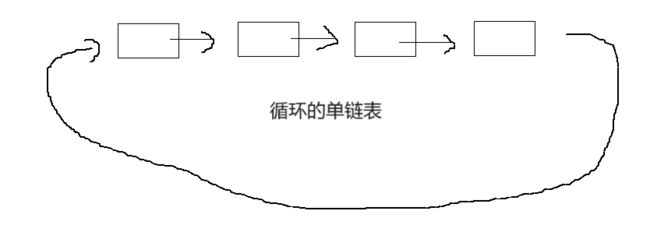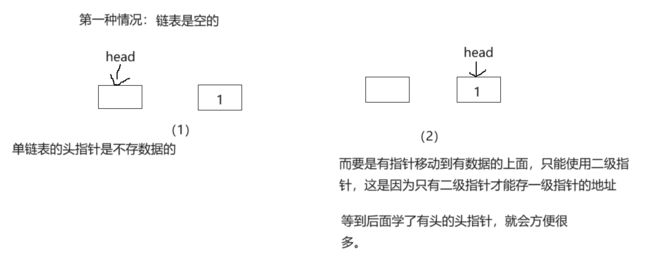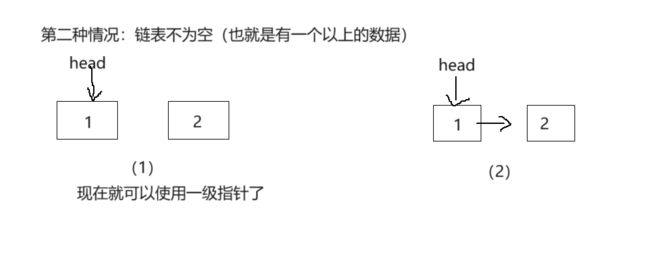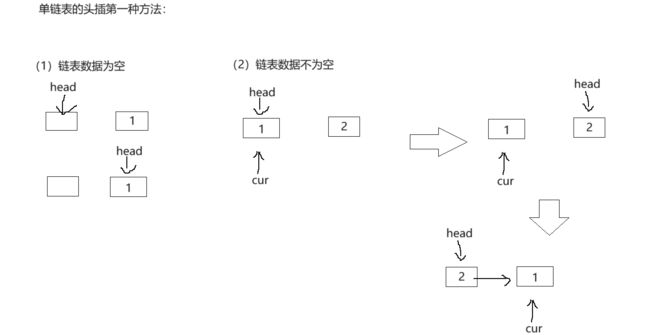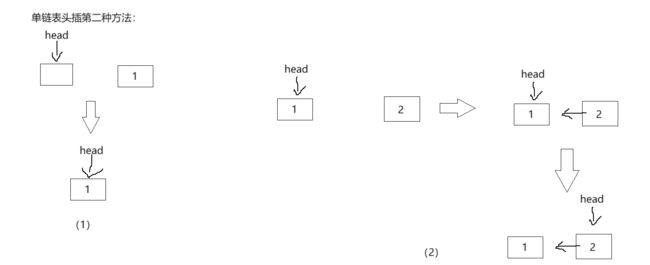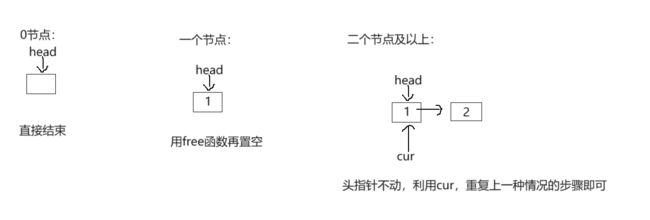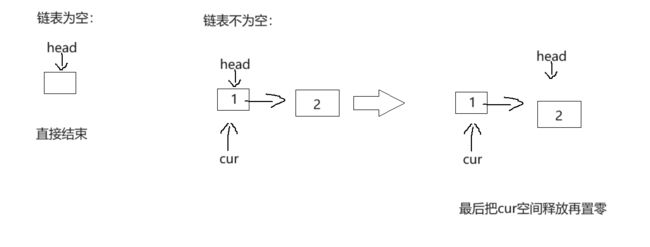单链表(数据结构与算法)
✅✅✅✅✅✅✅✅✅✅✅✅✅✅✅✅
✨✨✨✨✨✨✨✨✨✨✨✨✨✨✨✨
追风赶月莫停留
平芜尽处是春山
✨✨✨✨✨✨✨✨✨✨✨✨✨✨✨✨
✅✅✅✅✅✅✅✅✅✅✅✅✅✅✅✅
单链表
- 单链表的定义
- 单链表的结构
-
- 循环的单链表
- 不循环单链表
- 单链表增删查改(无头+单向+非循环链表增删查改实现)
-
- 其它接口
- 动态申请一个节点
- 单链表打印
- 单链表尾插
- 单链表的头插
- 单链表的尾删
- 单链表头删
- 单链表查找
- 单链表在pos位置之后插入x
- 单链表删除pos位置之后的值
- 单链表整体代码的实现
单链表的定义
单链表:一种链式存取的数据结构,用一组地址任意的存储单元存放线性表中的数据元素。链表中的数据是以结点来表示的,每个结点的构成:元素(数据元素的映象) + 指针(指示后继元素存储位置),元素就是存储数据的存储单元,指针就是连接每个结点的地址数据。
上图就是一个简单的空的(没有装数据)单链表
单链表的结构
循环的单链表
typedef int SLDatatype;
typedef struct SListNode
{
SLDatatype val;
struct SListNode* next;
}SListNode;
这就是循环的单链表
不循环单链表
typedef int SLDatatype;
typedef struct SListNode
{
SLDatatype val;
struct SListNode* next;
}SListNode;
这就是不循环的单链表,而且没有装入数据
循环单链表和不循环的单链表创建是一样的只不过是在结尾的时候,循环的单链表中最后一个也就是尾指向了头,而不循环的单链表中的尾指向了空(NULL)
单链表增删查改(无头+单向+非循环链表增删查改实现)
其它接口
#include动态申请一个节点
// 动态申请一个节点
SListNode* BuySListNode(SLDatatype x)
{
SListNode* cur = (SListNode*)malloc(sizeof(SListNode));
if (cur == NULL)
{
perror("malloc faild");
exit(-1);
}
cur->val = x;
cur->next = NULL;
return cur;
}
大家如果对于malloc和realloc以及空间的创建的用法有些遗忘,可以看我这篇博客:动态内存管理(这是一个链接,有需要的朋友可以直接点进去)
单链表打印
// 单链表打印
void SListPrint(SListNode* ps)
{
//为保存头指针的位置
//需要重新定义一个指针来移动
SListNode* cur = ps;
while (cur)
{
printf("%d->", cur->val);
cur = cur->next;
}
printf("NULL\n");
}
因为在链表这里,都是指针移动,所以我们需要保存头指针的位置不变,故需要重新定义一个指针来移动。
单链表尾插
// 单链表尾插
void SListPushBack(SListNode** ps, SLDatatype x)
{
SListNode* new = BuySListNode(x);
//尾插要分两种情况
//第一种是链表里是为空的,而为空,就需要用到二级指针来改变结构体的指针
//第二种是链表里数据不为空的
if (*ps == NULL)
{
*ps = new;
}
else
{
SListNode* cur = *ps;
while (cur->next != NULL)
{
cur = cur->next;
}
cur->next = new;
}
}
注意:
尾插要分两种情况
(1)第一种是链表里是为空的,而为空,就需要用到二级指针来改变结构体的指针
(2)第二种是链表里数据不为空的
大家可能对于这个没有头的头指针还是难以理解,尽可能去理解吧,我刚开始学习这个也是这样,不过单链表题写多了以及学了后面带头的头指针就会好很多。
第二种情况还是很好理解的
单链表的头插
// 单链表的头插第一种方法:
void SListPushFront(SListNode** ps, SLDatatype x)
{
SListNode* new = BuySListNode(x);
if (*ps == NULL)
{
*ps = new;
}
else
{
SListNode* cur = *ps;
*ps = new;
new->next = cur;
}
}
// 单链表的头插第二种方法:
void SListPushFront(SListNode** ps, SLDatatype x)
{
SListNode* new = BuySListNode(x);
new->next = *ps;
*ps = new;
}
这两种方法都挺好理解的
单链表的尾删
// 单链表的尾删
void SListPopBack(SListNode** ps)
{
assert(*ps);//防止链表为空
if ((*ps)->next == NULL)//只有一个节点
{
free(*ps);
*ps = NULL;
}
else //两个节点及以上
{
SListNode* cur = *ps;
while (cur->next->next != NULL)
{
cur = cur->next;
}
free(cur->next);
cur->next = NULL;
}
}
注意节点个数
在尾删就得看节点个数了,然后分为三种情况,0节点和一个节点、两个节点及以上
单链表头删
// 单链表头删
void SListPopFront(SListNode** ps)
{
assert(*ps);//防止链表为空
//链表不为空
SListNode* cur = *ps;
*ps = cur->next;
free(cur);
cur->next = NULL;
}
上面的尾插,头插,尾删,了解后,这里应该都能很好的理解了
单链表查找
// 单链表查找
SListNode* SListFind(SListNode* ps, SLDatatype x)
{
assert(ps);
SListNode* cur = ps;
while (cur->next != NULL)
{
if (cur->val == x)
{
return cur;
}
cur = cur->next;
}
return NULL;
}
这个查找就很简单了,直接遍历一遍就可以了,注意一下循环停止的时间
单链表在pos位置之后插入x
// 单链表在pos位置之后插入x
void SListInsertAfter(SListNode* pos, SLDatatype x)
{
assert(pos);
SListNode* cur = pos->next;
SListNode* new = BuySListNode(x);
if (new == NULL)
{
perror("malloc faild");
exit(-1);
}
pos->next = new;
new->next = cur;
}
单链表删除pos位置之后的值
// 单链表删除pos位置之后的值
void SListEraseAfter(SListNode* pos)
{
assert(pos);
assert(pos->next); //检查是否是尾节点
SListNode* cur = pos->next;
pos->next = cur->next;
free(cur);
cur = NULL;
}
在这里注意一下pos是否为尾节点
单链表整体代码的实现
#include传地址的时候注意:有一些函数只需要传一级指针就可以了,而有些函数需要传二级指针。在这里一级指针直接传结构体就可以了,这是因为我们定义的是指针的结构体,而二级指针就需要传结构体的地址了。

